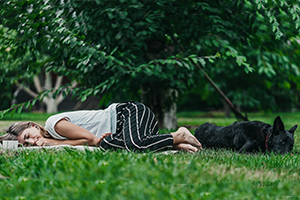22.1 Present Tense of Verbs (Лежати and Сидіти Types)

In this module, you will learn the present-tense endings of two verb types that belong to the second conjugation. To make remembering them easier, they are called here the лежа́ти (to lie) type and the сиді́ти (to sit) type.
Завдання 1
Mark all the forms of the verb “to lie” (i.e., be in a flat position) in the dialogue below. Then answer the questions that follow.
Важли́во!
The verb лежа́ти represents the pattern of hard-vowel endings in the second conjugation, which are similar but not the same as the hard-vowel endings of the first conjugation.
| писа́ти | лежа́ти | |
|---|---|---|
| я | пишу́ | лежу́ |
| ти | пи́шеш | лежи́ш |
| він/вона/воно | пи́ше | лежи́ть |
| ми | пи́шемо | лежимо́ |
| ви | пи́шете | лежите́ |
| воні | пи́шуть | лежа́ть |
Note especially the ending in the third-person singular (–ить), which is very different from the first conjugation and typical of the verbs in the second conjugation. Note also the different “connector” vowel (–и-) in the majority of forms and the -ать ending in the third-person plural.
Another common verb that belongs to the лежа́ти type is ба́чити (to see).
Завдання 2
Match each statement that you hear to the image it describes by placing the corresponding letter in the blank.

a.

b.

c.

d.
Завдання 3
Complete the snippets of conversation below using the verb forms from the bank.
Завдання 4
Mark all the forms of the verb “to sit” in the dialogue below. Then answer the questions that follow.

Важли́во!
The verb сиді́ти represents another common pattern of endings in the second conjugation. This pattern differs from the лежа́ти one in two ways: (1) in the first-person singular, there is always a consonant mutation before the ending and (2) the third-person plural takes the ending -ять. Compare:
| лежа́ти | сиді́ти | |
|---|---|---|
| я | лежу́ | сиджу́ |
| ти | лежи́ш | сиди́ш |
| він/вона/воно | лежи́ть | сиди́ть |
| ми | лежимо́ | сидимо́ |
| ви | лежите́ | сидите́ |
| вони | лежа́ть | сидя́ть |
The consonant mutations in the first-person singular depend on the last consonant before the infinitive ending (ex., д in сиді́ти): д → дж, с → ш, т → ч. Remember these common verbs of the сиді́ти type that undergo these mutations:
| д → дж | води́ти (машину) → воджу́ прово́дити (час) → прово́джу |
| с → ш | проси́ти → прошу́ носи́ти → ношу́ прино́сити → прино́шу |
| т → ч | плати́ти → плачу́ |
Note that these mutations occur ONLY in the first-person singular!
Завдання 5
Choose which person is more likely to make the statements below about themselves.
Завдання 6
Read the social media post below and then answer the questions that follow.

Я ношу́ окуля́ри, бо до́бре не ба́чу. Мої́ дві по́други теж но́сять окуля́ри. Ми всі студе́нтки, прово́димо бага́то ча́су за комп’ю́тером, ча́сто сидимо́ в інтерне́ті… Можли́во, тому́ в нас таки́й пога́ний зір (eyesight)? Я зазвича́й купу́ю окуля́ри в інтерне́т-магази́нах, бо шука́ю щось мо́дне і нестанда́ртне, і плачу́ креди́тною ка́рткою. По́тім наш пошта́р (mailman) прино́сить мої нові́ окуля́ри про́сто додо́му. Це ду́же зру́чно. Га́рні окуля́ри недеше́ві, але́ я не прошу́ гроше́й в батькі́в, бо вже працю́ю і отри́мую зарпла́ту (pay/salary). Ось мої́ нові́ окуля́ри! Вони́ сти́льні, пра́вда?
Завдання 7
Provide the correct verb forms to complete the answers to the question that you will hear. Then respond to the question that follows.
Завдання 8
Complete the phone conversation below using the verb forms from the bank.
Мо́вний пазл
Look through the activities you have just completed and choose the correct statements below to summarize what you have learned.
А тепе́р тест!
Complete the conversation between two friends meeting in a cafe by selecting the appropriate verbs from the bank and changing their forms as needed to fit the given context.

